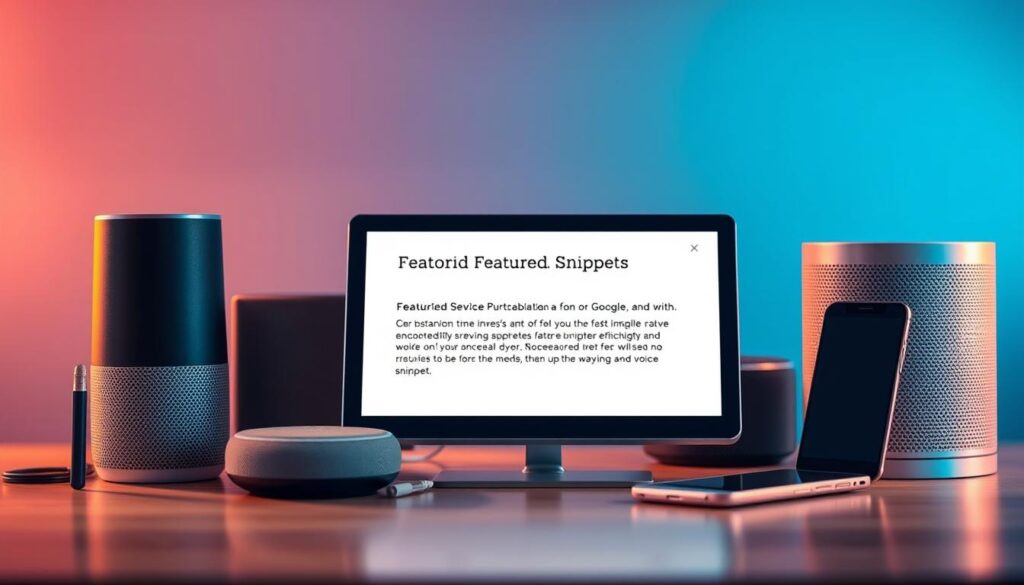The rise of AI-powered assistants like Siri, Alexa, and Google Assistant has led to a significant increase in voice search usage. As a result, search engine optimization (SEO) is evolving to incorporate voice search optimization (VSO).
With over 8.4 billion voice assistants projected to be in use by 2024, businesses must adapt their digital marketing strategies to stay ahead. The convenience and speed of voice search have driven its rapid adoption, with 41% of U.S. adults using it daily.
To capitalize on this trend, businesses need to understand how voice search works and implement effective optimization techniques. This comprehensive guide will walk you through the process, providing actionable insights to enhance your digital marketing strategy.
Key Takeaways
- Understand the importance of voice search optimization for your business.
- Learn how to adapt your content for voice search.
- Discover the role of AI in transforming voice search capabilities.
- Implement practical strategies to improve your digital marketing results.
- Stay ahead of the competition by capitalizing on the growing voice search trend.
The Rise of Voice Search in Digital Marketing
The rise of voice search is transforming the digital marketing landscape in unprecedented ways. As voice-enabled devices become increasingly ubiquitous, the way people search for information online is undergoing a significant shift.
Current Voice Search Usage Statistics
Voice search usage has seen a substantial surge in recent years. According to data from Google, 20% of searches in the Google App are done via voice. As of 2022, there were around 142 million users of voice assistants in the United States, a number that is forecast to increase to 157.1 million users by 2026. Statistics show that 27% of the global online population is using voice search on mobile, representing a significant shift in how people access information.
| Year | Voice Assistant Users in the US (in millions) |
|---|---|
| 2022 | 142 |
| 2026 | 157.1 |
Why Users Prefer Voice Search Over Traditional Text Search
The convenience factor is driving the adoption of voice search. It is three times faster than typing, allowing users to multitask while searching for information. Users are increasingly comfortable with voice technology, preferring it for its natural interaction style and the ability to get immediate answers without navigating through multiple search results. Voice searches tend to be longer and more conversational than text searches, with users asking complete questions rather than typing fragmented keywords.
Impact on Digital Marketing Strategies
This shift in search behavior is forcing marketers to rethink their digital marketing strategies to accommodate more natural language patterns and question-based queries. The impact on digital marketing is profound – businesses must now optimize for conversational keywords and focus on providing direct answers to common questions. Voice search is particularly important for local businesses, as many voice queries have local intent (e.g., “near me” searches), creating new opportunities for location-based marketing.
Understanding these trends is essential for staying competitive in the evolving digital landscape where voice search is becoming increasingly dominant. By adapting to the rise of voice search, businesses can improve their online visibility and stay ahead of the competition.
Understanding How Voice Search Works
As voice search continues to gain popularity, understanding its underlying technology is crucial for marketers and businesses. Voice search operates through a sophisticated process primarily driven by Automatic Speech Recognition (ASR) technology.
Voice search technology relies on complex ASR systems that convert spoken language into text that search engines can process. When a user initiates a voice search, the device captures the audio, filters out background noise, and digitizes the voice query for processing.
Voice Recognition Technology Explained
Voice recognition technology is a critical component of voice search. Advanced AI algorithms analyze sound patterns and use statistical methods to recognize individual words and arrange them into meaningful sentences. Modern voice recognition systems employ deep neural networks to model sounds, significantly enhancing speech recognition accuracy by understanding natural language patterns.

How AI Powers Voice Search Queries
AI plays a vital role in powering voice search queries. Once the spoken words are converted to text, the query is processed by search engines much like a traditional search, but with greater emphasis on understanding conversational context and user intent. This enables users to receive more accurate and relevant results.
Differences Between Voice and Text Search Behavior
Voice searches differ from text searches in several key ways – they’re typically longer, more conversational, and often phrased as questions rather than keyword phrases. Users approach voice searches differently, expecting immediate and direct answers rather than a list of results to browse through. Understanding these differences is essential for creating content that aligns with how voice search technology processes and responds to queries.
The Role of AI in Voice Search Optimization in Digital Marketing

Learn More
As voice search continues to gain popularity, the role of AI in optimizing digital marketing for voice queries becomes increasingly significant. AI technologies are transforming the way search engines interpret and respond to voice queries, making it essential for digital marketers to understand these advancements.
How AI Interprets User Intent in Voice Queries
AI plays a crucial role in interpreting user intent behind voice queries. Unlike traditional text-based searches, voice queries are often longer and more conversational. AI-driven systems, equipped with technologies like Natural Language Processing (NLP), can analyze the context and intent behind these queries, providing more accurate results.
Understanding user intent is key to delivering relevant search results. AI helps in deciphering the nuances of human language, including accents and dialects, to improve the accuracy of voice search results.
Natural Language Processing and Voice Search
NLP is a subset of AI that enables computers to understand and interpret human language. In the context of voice search, NLP allows search engines to process and analyze voice queries more effectively. This technology is crucial for improving the user experience by providing more accurate and relevant search results.
By leveraging NLP, digital marketers can optimize their content to better match the natural language patterns used in voice queries, enhancing their visibility in search results.
AI-Driven Personalization in Voice Search Results
AI also enables personalization in voice search results. By analyzing user behavior and preferences over time, AI-driven systems can deliver tailored results that are more relevant to individual users. This personalization aspect is crucial for digital marketers aiming to provide a more engaging and relevant user experience.
Personalization in voice search results not only improves user satisfaction but also opens new avenues for targeted marketing strategies, allowing businesses to connect more effectively with their audience.
Creating Conversational Content for Voice Search
As voice search continues to grow, creating conversational content has become crucial for digital marketing strategies. To rank effectively in voice search results, businesses need to focus on crafting content that mirrors the conversational nature of spoken queries.
Voice search queries tend to be longer and more natural compared to traditional text searches. This means optimizing for these nuances is crucial to improving search engine visibility. Instead of just focusing on broad keywords such as “best restaurants,” target more specific, voice-friendly phrases, such as: “What are the best family-friendly restaurants in downtown Chicago?”
Using Natural Language and Long-Tail Keywords
Creating conversational content is essential for voice search success, as voice queries typically use natural language patterns that differ significantly from typed searches. When optimizing content for voice search, focus on incorporating long-tail keywords that match how people actually speak.
For example, instead of targeting “pizza dough recipe,” use phrases like “how to make homemade pizza dough without yeast.” This approach not only improves your visibility in voice search results but also enhances the user experience by providing more relevant answers.
Structuring Content to Answer Direct Questions
Voice searches are often phrased as questions, so structuring your content to directly answer common questions in your industry can significantly improve your visibility in voice search results. Use natural, conversational language throughout your content that mirrors how real people speak.
Avoid overly technical jargon unless specifically targeting expert audiences. Consider the context in which voice searches occur – users might be driving, cooking, or otherwise occupied, so your content should provide value quickly and efficiently.
Implementing FAQ-Style Content for Voice Queries
FAQ sections are particularly valuable for voice search optimization, as they provide clear, concise answers to specific questions that voice assistants can easily extract and present to users. When creating FAQ content, research the actual questions your target audience is asking.
| Question Type | Example | Benefit |
|---|---|---|
| Direct Inquiry | “What are the best Italian restaurants in New York?” | Provides immediate, relevant answers |
| Problem-Solving | “How do I fix a leaky faucet?” | Offers step-by-step solutions |
| Comparative | “Which is better, iPhone or Samsung?” | Helps users make informed decisions |
By structuring your content with clear headings that pose questions, followed by concise answers, you can improve your chances of being featured in voice search results. Remember, voice search users want immediate, helpful answers, so prioritize clarity and directness in your content.
Technical SEO Considerations for Voice Search
Voice search optimization requires a multifaceted approach, with technical SEO playing a pivotal role in ensuring visibility and success. As voice search continues to grow, businesses must adapt their SEO strategies to meet the unique demands of this technology.
Mobile Optimization and Page Speed
Mobile optimization is critical for voice search success, as the majority of voice searches occur on mobile devices. Ensuring that your website is fully responsive and provides an excellent user experience across all screen sizes is non-negotiable. Page speed is also a top priority, as voice search users expect immediate results. Google’s emphasis on fast load times in its algorithm makes this a critical factor for voice search optimization.
Aim for pages that load in under three seconds, as slower pages are less likely to be featured in voice search results. Consider implementing Accelerated Mobile Pages (AMP) for key content to further improve loading speeds on mobile devices.

Structured Data and Schema Markup
Implementing structured data (schema markup) helps search engines better understand your content’s context, making it easier for voice assistants to extract and present relevant information. Schema markup is particularly valuable for local businesses, events, recipes, and FAQs – all common targets for voice searches.
By providing search engines with additional context about your content, you can improve your chances of being featured in voice search results.
HTTPS Security and Site Architecture
Secure websites (HTTPS) are preferred by search engines and voice assistants, as they provide a layer of trust and security that’s increasingly important for ranking well. Additionally, a logical and easy-to-navigate site architecture helps search engines understand the relationship between different pages and content.
Regular technical SEO audits are essential to identify and fix issues that might prevent your content from being selected for voice search results.
Local SEO Strategies for Voice Search Success

The rise of voice search has made local SEO a critical component for businesses aiming to reach their target audience effectively. With a significant portion of voice searches having local intent, businesses must optimize their online presence to appear in these search results.
Optimizing Google Business Profile for Voice Queries
Claiming and fully optimizing your Google Business Profile is a crucial step in local SEO for voice search. Ensure that all information is accurate, complete, and up-to-date, as this is often the primary source for voice assistants answering local queries. Consistency is key; include your complete business name, address, and phone number (NAP) across all online platforms.
Location-Based Keywords and Content
Incorporating location-based keywords naturally throughout your website content is vital. This includes city names, neighborhood references, and landmarks that potential customers might mention in voice searches. Create location-specific pages if your business serves multiple areas, with unique content tailored to each location.
Managing Online Reviews for Local Voice Search
Online reviews significantly impact local voice search rankings. Encourage satisfied customers to leave positive reviews and respond promptly to all reviews, both positive and negative. This not only improves your local SEO but also enhances your business’s reputation and trustworthiness.
By implementing these local SEO strategies, businesses can improve their visibility in voice search results, driving more local traffic and sales. It’s essential to stay ahead of the curve in voice search optimization to remain competitive in the digital landscape.
Featured Snippets: The Key to Voice Search Visibility
Featured snippets have become a crucial element in voice search visibility, as they are often the primary source for voice assistant answers. When users ask questions through voice assistants, the responses are frequently pulled directly from these snippets. Therefore, optimizing content to appear in featured snippets is vital for businesses aiming to improve their voice search rankings.
Voice assistants like Google Assistant, Siri, and Alexa prioritize featured snippets when responding to user queries. These “position zero” results appear above traditional search results and provide concise answers to specific questions, making them ideal for voice search queries.
How Voice Assistants Use Featured Snippets
Voice assistants rely heavily on featured snippets to provide quick and accurate answers to user questions. When a user asks a question, the voice assistant typically reads the content of the featured snippet verbatim. This makes it essential for businesses to optimize their content to win featured snippets.
To optimize for featured snippets, focus on clearly answering specific questions that your target audience is likely to ask through voice search. Use clear, concise language in your potential snippet content, avoiding jargon and keeping sentences short.

Formatting Content to Win Featured Snippets
To increase the chances of winning a featured snippet, format your content strategically. Use paragraph snippets for direct answers, numbered lists for ranked items or step-by-step instructions, or bulleted lists for unranked items.
Structuring content with header tags that pose common questions, followed immediately by clear, direct answers, is particularly effective for winning featured snippets. Incorporating FAQ sections that directly answer common questions is also an excellent way to increase the odds of ranking as a Featured Snippet.
| Content Format | Best Use Case |
|---|---|
| Paragraph Snippet | Direct answers to specific questions |
| Numbered List | Ranked items or step-by-step instructions |
| Bulleted List | Unranked items or lists |
Measuring Featured Snippet Performance
Tracking featured snippet performance is crucial to understanding their impact on voice search visibility. Use tools like SEMrush or Ahrefs to identify which queries trigger your snippets and how they perform over time.
“The key to maintaining and improving your featured snippet position is to continue refining your content based on performance data.”
Analyzing competitor snippets can also provide valuable insights into what content formats and approaches are working in your industry. By adapting your strategy accordingly, you can improve your chances of winning more featured snippets.
Voice Search Optimization Tools and Resources
Optimizing for voice search requires a multifaceted approach, leveraging the right tools to understand performance, identify opportunities, and refine your strategy.

To effectively optimize for voice search, it’s crucial to have the right tools and resources. These tools help in understanding how your website performs in voice search results, identifying relevant keywords, and testing your content’s compatibility with voice assistants.
Analytics Tools for Voice Search Performance
Google Search Console is essential for understanding your website’s performance in voice search. It provides data on search queries, including those from voice search. Use this tool to identify which queries drive traffic and adjust your content to match user intent.
Key Features: Data on search queries, traffic analysis, and content optimization insights.
Keyword Research Tools for Voice Queries
Tools like Ahrefs and SEMrush are invaluable for voice search marketing. They help you find relevant keywords, analyze competitors, and track your search performance. These tools also highlight long-tail keywords and question-based queries crucial for voice search optimization.
Specialized tools like AnswerThePublic, Keyword.io, and BuzzSumo can help identify question-based queries that people are asking in your industry, providing direction for voice-optimized content.
Voice Search Testing Platforms
Voice search testing platforms like Dialogflow and Botmock allow you to simulate voice interactions and test how your content might be interpreted by voice assistants. This helps in refining your content to better match voice search queries.
Benefits: Improved content relevance, better voice search compatibility, and enhanced user experience.
Case Studies: Successful Voice Search Marketing Campaigns
Successful voice search marketing campaigns are redefining how businesses interact with their customers. By examining these campaigns, we can gain valuable insights into effective voice search optimization strategies that businesses can adapt for their own efforts.
Domino’s Pizza Voice Ordering System
Domino’s Pizza was a pioneer in integrating voice search into their customer experience. They developed a voice-activated ordering system that works across multiple devices, including Amazon Echo and Google Home. By optimizing their site for common voice queries like “order a pizza” or “track my pizza order,” Domino’s improved their voice search online rankings and made the ordering process more convenient for customers. As a result, they saw a significant boost in mobile orders and overall sales.
Sephora’s Voice Assistant Integration
Sephora successfully integrated voice technology through their Virtual Artist tool, which works with Google Assistant to provide beauty advice, product recommendations, and tutorials through voice interaction. By creating voice-optimized content around common beauty questions, Sephora positioned themselves as an authority that voice assistants reference when users ask beauty-related questions. This strategy not only enhanced customer engagement but also drove sales through voice-activated channels.
Starbucks Voice Ordering Experience
Starbucks implemented voice ordering through their mobile app and Amazon Alexa, allowing customers to place their usual orders by simply saying “Order my Starbucks” – a perfect example of combining voice technology with personalization. Their voice ordering system remembers customer preferences and previous orders, creating a seamless experience that has significantly increased mobile order frequency and customer loyalty.
As these case studies demonstrate, successful voice search optimization isn’t just about ranking in search results – it’s about creating useful voice-activated experiences that solve customer problems. By understanding user intent and creating content that directly addresses the questions and needs of their target audience, businesses can achieve significant gains in customer satisfaction and loyalty.
Future Trends in Voice Search Optimization
The landscape of digital marketing is on the cusp of a revolution, driven by the rapid evolution of voice search technology. As voice search continues to gain traction, businesses must adapt their strategies to remain competitive.
Several emerging trends are poised to reshape digital marketing strategies in the coming years. One significant trend is the growth of voice commerce.
Voice Commerce and Shopping
Voice commerce is gaining momentum, with projections suggesting that voice shopping will become a $40 billion industry. Businesses should prepare by optimizing product descriptions and creating voice-friendly purchasing processes to cater to the increasing number of users relying on voice assistants for shopping.
Multi-Modal Voice Search Experiences
Smart speakers and voice-enabled devices are becoming increasingly sophisticated, allowing for multi-modal experiences that combine voice with visual elements. This trend means businesses should optimize both their verbal content and visual assets for voice search queries.
Voice Search Privacy and Security Developments
As voice search becomes more prevalent, concerns about privacy and security are driving new developments. Users are demanding greater transparency about how their voice data is collected and used, prompting voice assistants to offer more personalized and secure experiences.
By staying ahead of these trends, businesses can capitalize on the growing importance of voice search in digital marketing and improve their visibility in search results.
Conclusion
As we’ve explored throughout this guide, the landscape of digital marketing is undergoing a significant transformation with the rise of voice search. The increasing use of voice-activated devices is changing how people find information online, making voice search optimization in digital marketing no longer optional but essential for businesses wanting to remain competitive.
To succeed in this new landscape, businesses must focus on understanding user intent and adapting their content to match the natural, conversational tone of voice queries. This involves using longer, more specific keywords and providing direct answers to common questions. Technical considerations such as mobile optimization, page speed, and structured data implementation are also crucial foundations for voice search success.
Local businesses, in particular, have strong opportunities in voice search optimization, as many voice queries have local intent. Optimizing your Google Business Profile and local content can yield significant results. Additionally, featured snippets represent one of the most direct paths to voice search visibility, as voice assistants frequently pull their answers directly from these prominent search results.
By implementing the strategies outlined in this guide, businesses can improve user experience and drive meaningful results. It’s essential to stay informed about emerging trends and continuously refine your digital marketing strategies to capture the growing audience of people who use voice search as their primary method of finding information online. Start by auditing your current content, identifying opportunities for voice optimization, and developing a systematic approach to implementing these changes across your digital presence.
